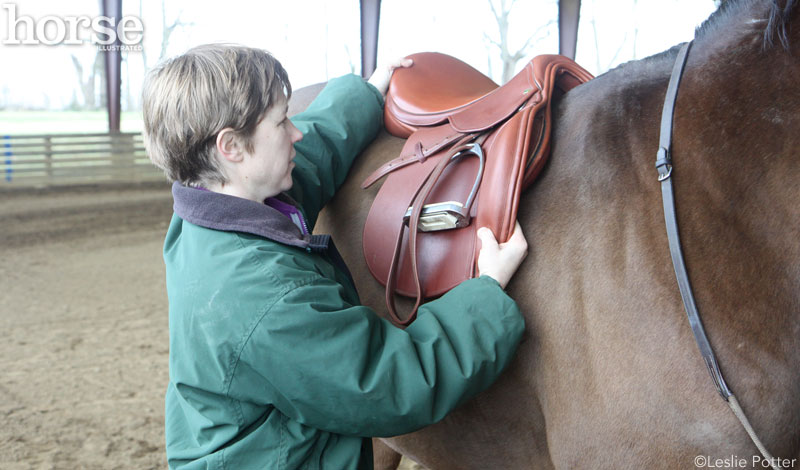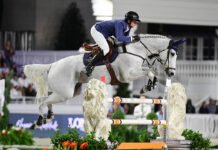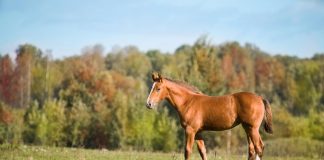HorseChannel spoke with Sara Ivie, a sales agent for County Saddlery (www.SaddleSolutionsLLC.com). Sara deals with riders, horses and saddle fit on a daily basis—she’s become a great interpreter for what a horse is trying to tell the rider about his saddle.
Sara Ivie: I started riding at 11 years old as a hunter; I did a little foxhunting, but ultimately fell in love with eventing. I currently ride an off-track Thoroughbred named Mikey.
HC: What got you interested in saddle fitting?
SI: My horse Tango used to buck horribly when landing from jumps. A County agent immediately solved the bucking problem with a County saddle. I found it fascinating that a saddle could make such a significant and immediate difference in behavior and performance, and managed to stumble into my ideal career with an incredible product.
HC: What was your degree in college and do you use that degree? Do you have any specific training for this job?
SI: I have a bachelor’s degree in geography from Indiana University. My father told me when I started school that the purpose of a college degree, regardless of the chosen major, is to learn how to think, communicate and problem solve. These are the main qualities I use daily in my career, so yes, my degree is extremely helpful. With regards to County training, I have extensive and continuous training on County’s infinite design options available for horse and rider anatomies. I’m also certified by the Master Saddlers Association as a fitter. Every horse and rider I work with teaches me something.
HC: Describe what you do when you arrive at a saddle-fitting appointment. How long does an appointment take and how many can you do in one day?
SI: Each appointment I go to is fairly in-depth, and will take as long as the rider needs to feel comfortable with her choice. Sometimes that’s an hour, sometimes a couple of hours. The number of appointments I can do in a day varies, but I prefer to not do more than three or five new saddle fittings in one day so I can be thorough with each client.
First, I take an extensive evaluation of the horse, including health history and current riding situation. I then move on to more hands-on investigation, including back palpation, a symmetry exam, gait analysis, and static and dynamic fitting. In addition, I evaluate the horse in the saddle(s) he currently uses. We then move on to test riding multiple saddles back-to-back to determine rider’s preference in model and sizes, as well as the horse’s needs. I encourage the rider’s trainer to be involved as well to help describe specific riding and/or training issues the pair usually experiences, as well as to note the improvement an optimally fitting saddle makes in some or all of those issues.
HC: What clues are you looking for when you are watching the horse?
SI: First I look at the horse as a whole, including his basic conformation and symmetry. Following a thorough static evaluation, I do a dynamic fitting evaluation to determine how the horse moves under the saddle, and how his movement affects the saddle’s fit and balance. But even before I watch the horse actually working under the saddle, I carefully note his expression when being tacked up or even approached with a saddle in hand. Throughout the process the horse is responding, sometimes subtly, and often dramatically. Nothing the horse expresses can be ignored.
HC: Do you travel for your job? How often and where?
SI: Yes. I cover Indiana and Kentucky along with the help of some very able assistants. Saddle Solutions LLC is comprised of a team of helpers, including assistants in specific geographical areas, consultants with specific technical expertise, a customer service manager, and myself for final fitting determinations. I travel for appointments most weeks of the year, with the exception being weather extremes like tornadoes or brutal cold. I also work horse shows, where I’m able to assist many riders and horses in one location.
HC: What is your favorite part of your job?
SI: Making a significant impact on the comfort and performance of horses and riders. A rider’s equipment shouldn’t cause pain or interfere with performance, yet it often does.

Sara Ivie checks the fit of a new saddle on an off-track Thoroughbred at New Vocations in Lexington, Kentucky.
HC: How can you tell when a saddle does not fit properly?
SI: There are a myriad of elements to evaluate saddle fit both statically and dynamically. Some problems, like the inherent pressure points of synthetic (foam) panels, are obvious red flags that a saddle cannot be made to fit. Other saddles don’t reveal an issue until compared to something better. That’s why back-to-back saddle comparison via riding is so critical.
HC: How can you tell when a saddle does fit properly?
SI: A saddle fits well when both horse and rider are comfortable, meaning the rider feels secure and naturally balanced, and the horse’s behavior, quality of gaits and performance is maximized.
HC: Do you have any hints for riders about what they should be looking for in their horses to tell if saddle fit is an issue?
SI: There are a slew of issues that may or may not be saddle-fit related, including girthiness, bucking, tense back, wringing tail, trouble bending or changing leads, refusing jumps, recurring and inexplicable lameness, etc. Often people don’t realize though how much better their horses can perform until experiencing a well designed and optimally fitted saddle.
HC: What are the pros and cons of your job?
SI: It’s a major plus to be able to help horses and riders be even more comfortable and perform even better. Each appointment is slightly different, which keeps the job fresh, interesting, thought-provoking and rewarding. The down side is that the passion for my job takes time away from my riding passion. But what a blessing it is to have the “problem” of enjoying what I do.
HC: Is there anything you think people considering going into your profession should know? Do you have any words of advice for them?
SI: I think you have to have a real desire to help horses perform without pain; you have to want to get the best possible training and have the desire to never stop learning. If saddle fitting is something you might be interested in, it’s best to truly understand that this is a physical job requiring extensive travel, and that your business should be run like a business–that means you must learn not just saddle fitting, but customer service, scheduling, accounting and everything else that encompasses running a successful company.
Liked this article? Here are others on equestrian careers:
Equestrian Careers
The Equine Apprentice
Sarah Coleman has a soft spot for chestnuts with chrome, including
her two off-the-track Thoroughbreds that she competes in the hunters.
Based in Lexington, Ky., she is the Director of Education and
Development for New Vocations Racehorse Adoption Program.







d
Fascination.
This is a very interesting article outlining pretty much everything that we also teach our saddle ergonomists at Saddlefit 4 Life (www.saddlefit4life.com), however, the one thing that wasn’t really discussed was how the issues of asymmetry in the horse (which often causes saddle slip to one side if the gullet plate cannot be adjusted to accommodate the larger/higher shoulder) are dealt with. We have found that many traditionally built English saddles are simply not as adjustable as they really need to be – and this asymmetry is often unfortunately and inadvertently ignored – as is true fit to the rider (beyond the basic seat size, twist, and flap position/length). While the SMS and the QSF designation is definitely a step in the right direction, there should be more dialogue between empirical and scientific theories (including ours!)
Hey! I have been looking around and thinking of purchasing a western saddle online. But I’m afraid of getting the proper seat size. I’ve gone to many saddlery seat sizing charts but get different answers to my seat size. My measurement from kneecap to crease is 17 1/2″. Some charts say I need a 14″ seat some say 15″ some say 16″. So I’m Leary on what to do. I’m interested in the King series all around saddle and also some non branded barrel saddles. Can you offer any advice?